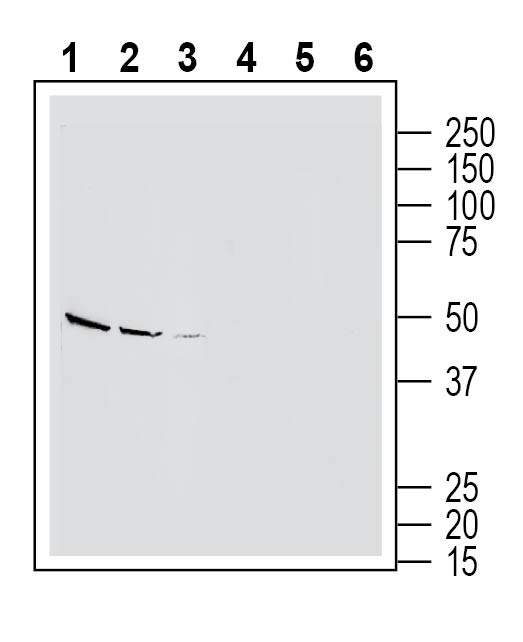Overview
- Peptide (C)KTSWTRGSNSSLMR, corresponding to amino acid residues 52 - 65 of rat EDNRB (Accession P21451). Extracellular, N-terminus.

 Western blot analysis of rat brain lysate (lanes 1 and 4), mouse brain lysate (lanes 2 and 5) and rat dorsal root ganglion lysate (lanes 3 and 6):1-3. Anti-Endothelin Receptor B (extracellular) Antibody (#AER-005), (1:200).
Western blot analysis of rat brain lysate (lanes 1 and 4), mouse brain lysate (lanes 2 and 5) and rat dorsal root ganglion lysate (lanes 3 and 6):1-3. Anti-Endothelin Receptor B (extracellular) Antibody (#AER-005), (1:200).
4-6. Anti-Endothelin Receptor B (extracellular) Antibody, preincubated with Endothelin Receptor B (extracellular) Blocking Peptide (BLP-ER005). Western blot analysis of mouse J774 macrophage cell line lysate (lanes 1 and 3) and rat aortic endothelial cells lysate (lanes 2 and 4):1-2. Anti-Endothelin Receptor B (extracellular) Antibody (#AER-005), (1:200).
Western blot analysis of mouse J774 macrophage cell line lysate (lanes 1 and 3) and rat aortic endothelial cells lysate (lanes 2 and 4):1-2. Anti-Endothelin Receptor B (extracellular) Antibody (#AER-005), (1:200).
3-4. Anti-Endothelin Receptor B (extracellular) Antibody, preincubated with Endothelin Receptor B (extracellular) Blocking Peptide (BLP-ER005).
- Davenport, A.P. (2002) Pharmacol. Rev. 54, 219.
- Boivin, B. et al. (2003) J. Biol. Chem. 278, 29153.
- Grant, K. et al. (2003) Br. J. Cancer. 88, 163.
Endothelins (ET-1, 2, and 3) are considered to be very powerful vasoconstrictive substances. In humans, endothelins mediate their actions via two specific G-protein coupled receptors, ETAR and ETBR. Both ETAR and ETBR are present in the heart and in human myocardium at similar levels.1,2
The endothelin receptors differ in their ligand specificity. While ETAR has varying affinities for the endothelin isoforms (ET-1 > ET-2 > ET-3), ETBR shows no selective affinity.2,3
Subsequent studies have demonstrated the presence of endothelins in vascular, as well as in non-vascular, cells and tissues, having multiple biological activities.
Currently, there is increasing evidence that ET-1 may modulate mitogenesis, apoptosis, angiogenesis tumor invasion and the development of metastases.3
Until recently, it was thought that all cellular activities of the endothelins were mediated through their interactions with their cell surface receptors. However, a recent study demonstrated that cardiac nuclei also possess both ETAR and ETBR subtypes, which are functional and coupled to signaling mechanisms within the nuclear membrane.2
Hypermethylation of the ETBR correlated with transcriptional down-regulation and reduced expression of ETB receptor was observed in several prostate, bladder and colon cancer cell lines.3
Application key:
Species reactivity key:
Anti-Endothelin Receptor B (extracellular) Antibody (#AER-005) is a highly specific antibody directed against an extracellular epitope of the rat protein. The antibody can be used in western blot and flow cytometry applications. It has been designed to recognize Endothelin Receptor B from rat and mouse samples. The antibody is not recommended for human samples.

